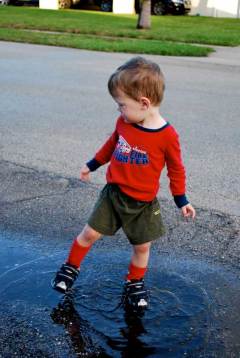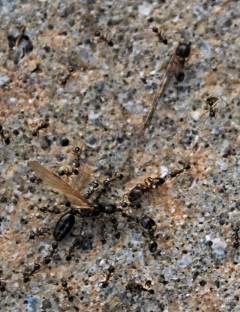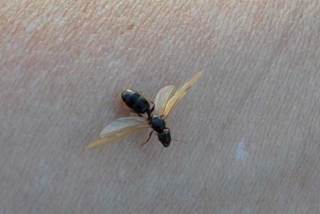Our neighbors across the street threw a Christmas party last night, and as luck would have it, it was one of the rainiest afternoon/evenings in recent memory. The streets were flooded, and I really regret not having been able to mow the lawn before the rain started…
But, luck tends to even out. This morning dawned bright and beautiful, and since Eric wouldn’t let me sleep, I decided to take him outside to enjoy the morning as only he knows how: splashing through puddles! (Last night as we went home from the party he spent about 5 minutes stomping through the Überpuddle, the puddle of all puddles, the one puddle to rule them all and in the darkness drown them). This morning’s puddle, by contrast, was quite tame, although he got to spend as long he wanted in them:
He got to splash to his heart’s content because Daddy was distracted by yet another spectacle of Urban Nature. Although the puddles had receded, the local ant colony decided that now was the time to go for it. Now was the time to hold their own holiday party, to boldly go forth in answer to nature’s call:
Click on the photo to see the larger version; small flying insects, unless they form swarms of truly ginormous proportion, simply don’t photograph all that impressively. But even so, you can see that there was something going on here. There must have been several hundred little winged ants all trying to find two precious commodities: a mate and a place to nest. After all, the purpose of the mating flight is, well, to mate.
Here is how Hölldobler and Wilson (1994) describe the mating flight of one common ant of the eastern United States:
At five o’clock on a sunny afternoon, if rain has recently fallen and if the air is still warm and humid, vast swarms of virgin queens and males emerge from the Lasius neoniger nests and fly upward. For an hour or two the air is filled with the winged ants, meeting and copulating while still aloft. Many end up splattered on windshields. Birds, dragonflies, robber flies, and other airborne predators also scythe through the airborne ranks. Some individuals stray far out over lakes, doomed to alight on water and drown. As twilight approaches the orgy ends, and the last of the survivors flutter to the ground. The queens scrape off their wings and search for a place to dig their earthen nest. Few will get far on this final journey. They must pass through a terrible gauntlet of birds, toads, assassin bugs, ground beetles, centipedes, jumping spiders, and other hunters of such vulnerable prey. Most deadly of all are worker ants, including those of the ubiquitous Lasius neoniger, always on the alert for territorial intruders.
Change the date (around Labor Day for L. neoniger, around Christmas for my neighborhood ants), change the time (this flight was well underway by 7:30 a.m., and didn’t last much past 9), and the above description applies pretty darn well to these Florida ants. Below is a detail from a photo that showed three such scenes within about 3 square feet:
Almost all castes are present: the winged reproductive hopeful, who appears to have run out of luck, the large soldier ants, and the small worker ants. These latter two castes appear intent on making a meal of what I can only assume is their queen’s offspring. Nature red in tooth and claw, indeed!
But these reproductive ants aren’t all that aggressive; I allowed several to land on me in hopes of getting a decent photograph with some sense of the scale of the animals, and not one of them so much as offered to bite; not so the sneaky little mosquitoes who tried to impose on my hospitality in the same manner. Those, I swatted. I may be OK with most insects, and I understand the role the mosquito has to play, but I draw the line at willingly providing these ladies a blood meal.
The long passage I quoted above from Hölldobler and Wilson talks about ants furiously copulating in midair. This subtropical species doesn’t seem to hold with that; I couldn’t find a single mated pair, although I wasn’t able to search as intensively as I’d have liked. Myrmecologists are not advised to bring their adorable toddlers with them into the field, particularly when that field is a sidewalk next to a street. The church at the end of the block disgorges swarms of vehicle traffic directly into our street, and the early mass ended right around the time Eric saw his opportunity to reenact Splashdance. Thus, yet another adventure of this urban naturalist was curtailed, but not scuttled. At least I got some pictures!
I’ve posted the pictures to bugguide.net, but despite the great success I’ve had with the folks there, I don’t have high hopes of anyone being able to identify these ants to species, or even to genus. I simply couldn’t get a good enough close-up of these guys, and I’m not big into capturing insects, even in the interests of research. And really, I’m not doing research on these guys. I’m just noticing them and their ant-ics as an interesting addition to the fauna of my neighborhood.
[UPDATE: the folks at bugguide have given me some leads, and what looks like a solid identification! A Mr. James Trager tells me: “Can’t tell the species from the pictures, but the waist of two segments plus two distinct sizes and shapes of workers clinches the genus for the Florida ant fauna. If this is the common one in urban southern Florida Pheidole as you note, then likely the non-native, invasive Ph. megacephala. The winged one is a female.”]







